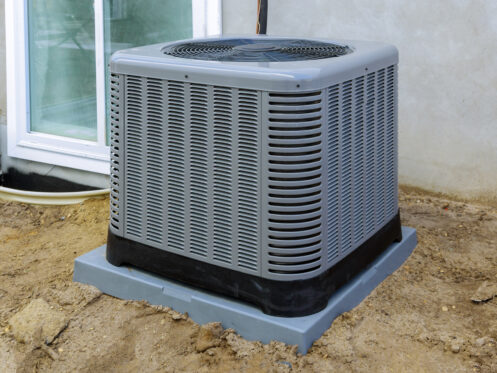Your HVAC system is vital for keeping your home comfortable, but it also uses a lot of energy. The EPA suggests that 43% of all energy used in the United States is related to heating and cooling. It is also one of the largest contributors to the average home’s carbon footprint. The good news is that you do not have to choose between environmental responsibility and comfort. In addition, it is possible to go green and reduce your HVAC system’s carbon footprint without increasing your heating and cooling costs. Three of the easiest ways to accomplish these goals are to install modern energy-efficient equipment when it is time for replacements, have an HVAC professional upgrade your thermostat to a smart model, and replace air filters when necessary.
1. Choose Efficient Air Conditioners and Heaters
Energy efficiency starts with the heating and cooling systems that keep your home at the ideal temperature throughout the year. Most heating and cooling equipment has a lifetime of 10 to 15 years. As heaters and air conditioners age, they become less efficient. For instance, many experts agree that air conditioners become 50% less efficient than they were when installed by the time they are 10 years old. Not only does aging equipment increase energy bills, but it requires your heating and cooling systems to run longer to maintain the temperature in your home and contribute to your household’s carbon footprint.
There are two other issues to consider regarding your equipment’s age. One is that as your heating or cooling system nears the end of its expected lifetime, it becomes prone to malfunctions that require frequent repair. If an upcoming repair will cost you half of what a new system will cost, it makes financial sense to consider an upgrade. The other consideration is that as HVAC equipment ages, it may not be able to keep up with your home’s heating and cooling demands. Signs of this issue include hot and cold spots in your house and your home not feeling comfortable even when you set your thermostat to the desired temperature.
Modern HVAC systems are much more efficient and have a longer useful lifetime than older ones. New systems benefit from technological advances, such as variable-speed motors. Traditional furnaces and air conditioners have one speed. When your thermostat calls for heating or cooling, the system turns on full blast until the desired temperature is reached. This is similar to flooring the gas in your car when getting on the highway to get up to travel speed, which burns a lot of gasoline.
Alternately, a variable-speed air conditioner or heater can maintain the comfort level in your home once it is at the set temperature without running at full capacity. Just like a car with speed control engaged once you are on the highway, modern heating and cooling systems require much less energy to maintain the temperature in your home. This results in lower monthly energy bills and reduces your household’s contribution to global warming. In addition, because your equipment is not running at full capacity all the time, it reduces the wear and tear on the system. This reduction in wear and tear can result in fewer repair expenses and longer-lasting HVAC systems.
If you need an upgrade, choosing a new system with variable-speed motors and other modern advancements has many advantages, including reduced greenhouse gas emissions. However, the initial cost of the most efficient heating and cooling systems will be higher than systems that may not have the latest technologies but are still more efficient than your current equipment. An HVAC professional can help you determine how much a more expensive heating and cooling system will reduce your monthly utility bills and your carbon footprint. This information can help you decide on a heater or air conditioner with a good balance between future energy savings, your environmental goals, and what you can afford to install a new system.
2. Consider a Smart Thermostat
You may have a programmable thermostat, which can reduce your energy consumption by adjusting the set temperature in your home based on your household members’ daily routines. For example, you can program it to reduce heating waste in the winter by lowering the temperature at night when everyone is asleep or out of the house for work or school. With this type of thermostat, you can set it so that the temperature will adjust back to the comfort level you desire before family members get up or arrive home.
While you can program smart thermostats in the same way, many offer features that eliminate the need for you to input and constantly update your family members’ schedules. They have learning algorithms to understand your household members’ routines and automatically adjust your house’s temperature to the most appropriate level. This technology can help you reduce monthly utility bills and energy waste because it does not depend on you having the time and inclination to reprogram a thermostat every time a family member makes a change to their weekly schedule.
In addition, a smart thermostat is connected to your home Wi-Fi network, allowing you to control your HVAC system remotely with an app on a smartphone or other device. This comes in handy if you leave for vacation or a business trip and forget to adjust the temperature before you leave or would like to make adjustments when at work.
Another benefit of a smart heating and cooling system is that the app provides data on your monthly heating and cooling use. This data can help you understand whether your efforts to reduce your carbon footprint and monthly energy bills are effective and may suggest areas for improvement. For instance, if you have a zoned system, the app can point you to zones in your house that consume more energy, such as a living room with outdated insulation and windows that cost you more than it should to heat and cool each year.
3. HVAC Air Filter Maintenance
Changing out air filters when necessary is one of the simplest ways to ensure your heating and cooling systems operate efficiently. An air filter’s primary purpose is to prevent dirt and debris from entering your heater or air conditioner and damaging internal components. However, they also capture airborne contaminants that would otherwise recirculate through your home’s forced air system and end up in the air your family breathes.
When an air filter becomes clogged, it inhibits proper airflow through your heating or cooling system. This situation causes your air conditioner or heater to work much harder to maintain your home’s temperature. Along with causing unnecessary wear and tear, poorly maintained air filters can lead to higher utility bills and more energy use, increasing your HVAC system’s environmental impact. HVAC experts recommend that you change HVAC filters at least once every three months and inspect them once a month. Monthly inspections are necessary because they will let you know if you need to change filters more frequently than recommended based on factors like if you have pets who shed a lot and how many people live in your household.
Contact the Professionals
At Atticman Heating and Air Conditioning, Insulation, we have served the residents of Sacramento, CA, and the surrounding areas for over 10 years. We install, maintain, and repair heating and cooling systems. Additionally, we provide ductwork, water heater, and insulation services. Contact us today to schedule an appointment with one of our expert HVAC technicians.


